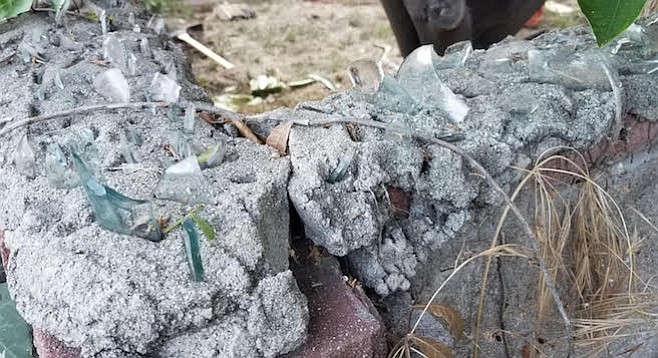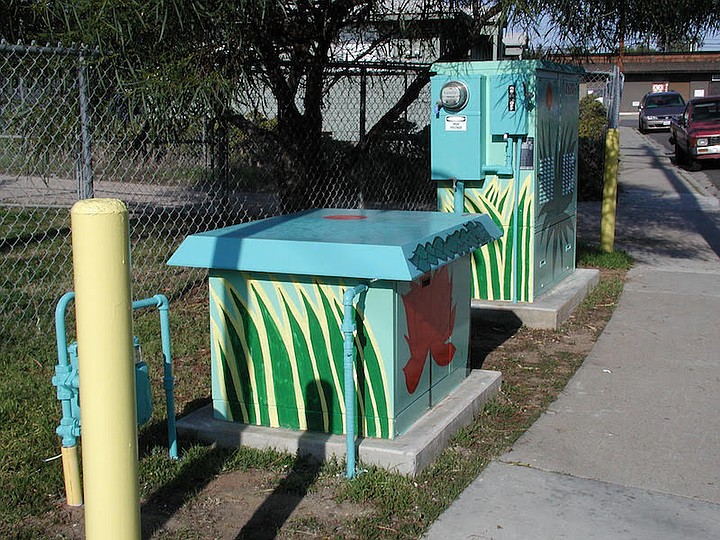 Facebook
Facebook
 X
X
 Instagram
Instagram
 TikTok
TikTok
 Youtube
Youtube

“The broken glass in the concrete wall has gone too far,” Ted said. He was referring to a three-foot-wall in his neighborhood where people used to loiter and sit. It has a layer of uneven cement on top with shards of glass jutting from it. “It creates a personal hazard to anyone that might be walking in the easement, and should be removed.”
Ted is a 54-year-old Oak Park resident in the retail business. He purchased his home in 2002 and he said he has been noticing more and more low-tech deterrents around his neighborhood — to make it difficult for homeless people to loiter, trespass, or squat.

“I think the sprinkler system by the back gate, or the misting system mounted along a fence line will only work until someone figures out a way to defeat that type of defense,” he said. “In the homeless case it’s installed over where they sleep, so with a twist of a knob up by the hose, they will have [water] on their stuff and [they] will move. If anyone says anything, it’s nothing more than watering the homeowner’s plants.”
When a neighbor saw the various do-it-yourself deterrents that Ted and others were posting on a social media thread called “Suggestion For Discouraging Illegal Activity Next To Your Property,” she responded, “This entire post is so dehumanizing. I feel embarrassed that our communities have people like this in them.”
Sandi, 63, lives a couple of miles away from Ted and posted photos of her cacti. She and her late husband planted it by her fence to “make an excellent fire break, that was our main motive. But now I am glad it is there to provide some level of security for me. With the homeless camps increasing by the day, property owners like me, have a deep fear of these invaders starting fires, bringing disease, causing damage to property, and breaking into homes and garages.”
Ted agreed and said, “Especially in this day and age people need to feel secure in their own areas [and] as long as it doesn’t do physical harm and is just preventive, I personally don’t have a problem with defending your space.”
Sandi said, “I have actually had them jump my seven-foot-fence [last February] and come onto my deck at 3 a.m. [He was] trying to get into my bedroom door [and] thankfully officers arrived quickly and took him away.” She added that “Last year they came through my yard and went into my garage twice…ransacked my car, stole supplies that I kept in the garage.”


Linda, another neighbor, then posted a photo of a utilities box that she painted (legally) in 2004. “My neighbors who lived directly across from the box smeared Crisco on the top to keep some gang types from sitting there to smoke and drink. [Then] one time [utilities workers] thoroughly cleaned the Crisco off the top [and] I thought it would be okay as I had not seen gang types around for a long time. I’m pretty sure it was the same day that a group of homeless individuals discovered that it was available to sit on and they spent an entire afternoon there. So I ran to the store and bought a can of Crisco and reapplied it after they left.”
It is not just the residents installing low-tech deterrents.
“San Diego installed sloped benches (airport) [and] divided seating at bus stops to prevent homeless from sleeping there [too],” Ted said.
Last year, the city embedded rocks in concrete in areas where many homeless people camped out. “You are so worthless that they will put down sharp rocks in the only place where you can find shelter is just beyond my imagination that anyone could think that that’s a solution,” said Jeenie Criscenzo, a homeless advocate, in an interview with the 10News.
“The others who defend [the homeless] are obviously not property owners," said Sandi, "or they simply do not understand the magnitude of filth and blight that the homeless campers bring. It’s up to the city to take care of this problem, really, not us innocent property owners.”


“The broken glass in the concrete wall has gone too far,” Ted said. He was referring to a three-foot-wall in his neighborhood where people used to loiter and sit. It has a layer of uneven cement on top with shards of glass jutting from it. “It creates a personal hazard to anyone that might be walking in the easement, and should be removed.”
Ted is a 54-year-old Oak Park resident in the retail business. He purchased his home in 2002 and he said he has been noticing more and more low-tech deterrents around his neighborhood — to make it difficult for homeless people to loiter, trespass, or squat.

“I think the sprinkler system by the back gate, or the misting system mounted along a fence line will only work until someone figures out a way to defeat that type of defense,” he said. “In the homeless case it’s installed over where they sleep, so with a twist of a knob up by the hose, they will have [water] on their stuff and [they] will move. If anyone says anything, it’s nothing more than watering the homeowner’s plants.”
When a neighbor saw the various do-it-yourself deterrents that Ted and others were posting on a social media thread called “Suggestion For Discouraging Illegal Activity Next To Your Property,” she responded, “This entire post is so dehumanizing. I feel embarrassed that our communities have people like this in them.”
Sandi, 63, lives a couple of miles away from Ted and posted photos of her cacti. She and her late husband planted it by her fence to “make an excellent fire break, that was our main motive. But now I am glad it is there to provide some level of security for me. With the homeless camps increasing by the day, property owners like me, have a deep fear of these invaders starting fires, bringing disease, causing damage to property, and breaking into homes and garages.”
Ted agreed and said, “Especially in this day and age people need to feel secure in their own areas [and] as long as it doesn’t do physical harm and is just preventive, I personally don’t have a problem with defending your space.”
Sandi said, “I have actually had them jump my seven-foot-fence [last February] and come onto my deck at 3 a.m. [He was] trying to get into my bedroom door [and] thankfully officers arrived quickly and took him away.” She added that “Last year they came through my yard and went into my garage twice…ransacked my car, stole supplies that I kept in the garage.”


Linda, another neighbor, then posted a photo of a utilities box that she painted (legally) in 2004. “My neighbors who lived directly across from the box smeared Crisco on the top to keep some gang types from sitting there to smoke and drink. [Then] one time [utilities workers] thoroughly cleaned the Crisco off the top [and] I thought it would be okay as I had not seen gang types around for a long time. I’m pretty sure it was the same day that a group of homeless individuals discovered that it was available to sit on and they spent an entire afternoon there. So I ran to the store and bought a can of Crisco and reapplied it after they left.”
It is not just the residents installing low-tech deterrents.
“San Diego installed sloped benches (airport) [and] divided seating at bus stops to prevent homeless from sleeping there [too],” Ted said.
Last year, the city embedded rocks in concrete in areas where many homeless people camped out. “You are so worthless that they will put down sharp rocks in the only place where you can find shelter is just beyond my imagination that anyone could think that that’s a solution,” said Jeenie Criscenzo, a homeless advocate, in an interview with the 10News.
“The others who defend [the homeless] are obviously not property owners," said Sandi, "or they simply do not understand the magnitude of filth and blight that the homeless campers bring. It’s up to the city to take care of this problem, really, not us innocent property owners.”
Comments